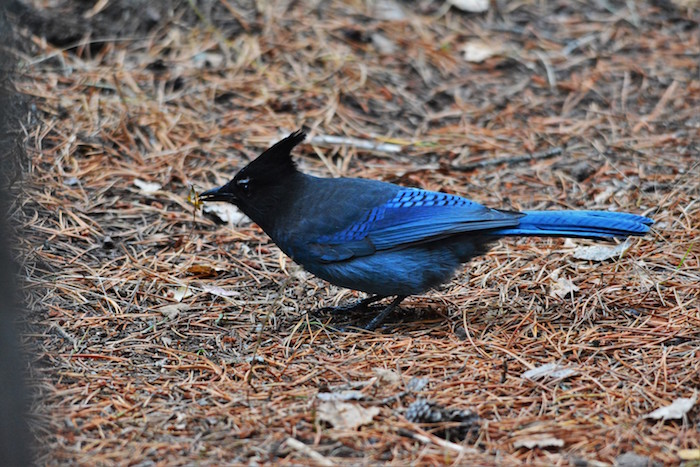Schiess: Stellar’s Jays: smarter than your average bird
Published at
“SHAACK, SHAACK, SHAACK,” sounds came from the large blue and black Jay as it landed on a branch while I was eating my sandwich in the Moody area east of Rexburg last Saturday.
I tossed it a piece of crust and the Steller’s Jay was soon joined by a Mountain chickadee and a chipmunk. I did not understand the Jay’s language, but other species did as even a Black-billed magpie came calling.
The fall is my favorite time when I can load my hunting gear, camera equipment and my chain saw in my truck and head for the mountains where a variety of different birds and animals can be found. If I prepare well, every outing is a great success as even the colorful sunrise is a reward and may make the day a success.
The Steller’s Jay hides and stores food as do most birds and animals that call the mountains home during the winter. Yet the Steller’s is recognized as far more intelligent than most of those other birds. The Steller’s Jay, with its stunning crest, is adept at imitating the sounds of many birds from warblers to hawks. They will often imitate the sounds of Red-tailed hawks to scare off competitors. Their common call, though, is a series of three brassy “shack, shack, shack,” and is unmistakable for serious birders.
When food is abundant they will often hide some in cracks in trees and rocks, even burying supplies in the ground and under leaves. Unlike those of us that are encouraged to have a six-month supply, they usually do. Recently in Island Park a sunflower was found growing out of a standing dead tree. The seed was probably hidden there by a Steller’s Jay or a chickadee, who stole the seed from someone’s feeder.
These birds are not too picky about what they eat, either. Berries, nuts, insects, seeds, eggs, chicks, and even fat and rotten meat from dead carcasses are used. In the winter as much as 95 percent of their diet may be stored food.
Often called a Blue Jay, the Steller’s Jay is a close cousin of the lighter colored cousin. Steller’s live in the Rocky Mountains or west along the West Coast while Blue Jays live east of the Rocky Mountains. In Colorado where both species inhabit, they are related close enough to interbreed making for some interesting coloration patterns in the offspring.
The only white coloration on Steller’s Jays are eyebrows and parts of the eye while Blue Jays have white chests and bellies. Both species are also the only two of the Jay family to use mud to build their nests.
The Steller’s Jays live year around in conifer forests preferring the large forests of fir trees as their home. They may migrate from higher to lower elevations during the winter as food becomes scarce, but they do not migrate south. They inhabit forests from Alaska to Central America varying in coloration and feeding habits. The Steller’s Jay is also the provincial bird of British Columbia.
During breeding a male will try to attract a mate by feeding her and dancing around her, often changing direction during the hop. During nest building and nesting, both male and female will protect the nest from other raiding Jays. Jays are also very quiet around the nest as to not attract unwanted predators.
After nesting, Steller’s Jays gather into loose groups called a “scold” and the groups will fly from one patch of trees to another in single file, not as a group.
These show-off birds can provide a lot of enjoyment for campers as they invade campsites and picnic areas with their incessant chatter and antics.
But last Saturday this single Jay and the early morning sunrise made my day a success as I enjoyed a fall day full of exercise and wonderment.






